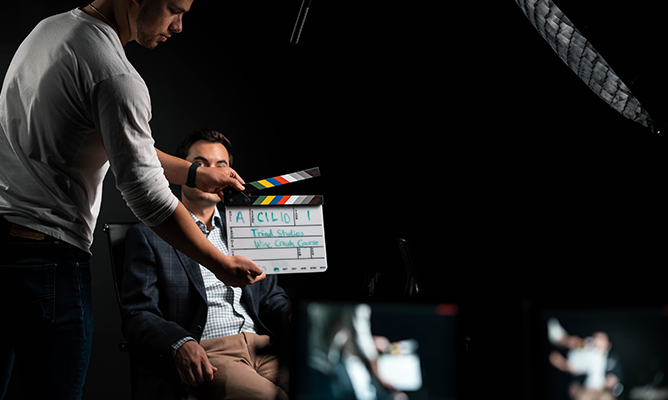Oftentimes when starting out in video production and editing, many developing filmmakers tend to focus all of their attention on solely the visual components of their projects. However, the auditory experience is just as important for viewers as the visuals themselves.
There are many different styles of video in the corporate and commercial video genres that require interviews to facilitate the narrative and flow of the story. For example, you may be crafting an overview video for a brand where the CEO is recounting the company’s founding story, or you might be producing a commercial documentary that requires interview footage with a high level of warmth and clarity. Whatever the situation, reducing background noise, equalization, and compression are the critical first steps to mastering interview audio.
Noise reduction and audio restoration
Unless you only record interviews in a room covered with acoustic foam and your equipment makes no noise, you will need to reduce the background noise in your recording. Lights, monitors, and HVAC units are just a few examples of often unavoidable sounds that can create consistent hums and buzzes outside of a controlled studio.
When applying noise reduction to an audio clip, make sure you don’t reduce noise at the expense of the interview dialogue quality. The noise reduction effect takes a sample of consistent and unwanted frequencies and cuts them out of the overall clip. High noise reduction levels can potentially cut out too many frequencies which can lead to dialogue having glitchy artifacts or sounding robotic. Also consider that a clip recorded with a lavalier microphone may not need much noise reduction while a clip recorded with a shotgun mic may have more machine rumble or fan noise.
For a more detailed explanation, check out this guide on Mastering Interview Audio that walks you through every step of the noise reduction process in Adobe Audition.
Equalization (EQ)
Equalization is the balance of audio across different frequencies. The human ear can recognize sounds between 20 Hz and 20,000 Hz. Different ranges of frequencies are responsible for certain acoustic qualities in a vocal. These ranges will vary slightly depending on the timber of the subject’s voice. For example, most of the fundamental frequencies for a female vocal will typically reflect higher frequencies than for a male vocal.
Regarding the EQ of interview audio specifically, your attention should be generally focused on shaping the following range of frequencies to achieve different acoustic effects:
- Low end rumble in the low lows (~0 Hz – 100 Hz):
- It is likely that any frequencies recorded below ~100 Hz are due to machine rumble or other vibrations that are not crucial to any quality in the vocal. Use a sharp low cut (high pass) to eliminate these from the recording. Refer to the following picture:

- Warmth in the lows (~100 Hz – 300 Hz):
- The majority of bass in a vocal lies in this range and is largely responsible for the overall warmth in the vocal. Try adding 2-6 dB in this range if you need more warmth. But be careful; too much warmth in a vocal can make it sound boomy. Think of your mic placement; a vocal recorded with a lavalier mic placed on a subject’s chest may already have good coverage in the lows and may not need to be increased. Your EQ curve with a slight boost of warmth may look something like this:

- Clarity in the mids and high mids (~2 kHz – 8 kHz):
- This range includes fundamental frequencies in the intelligible parts of a vocal. Sibilant sounds from different consonants such as -f’s, -k’s, -p’s, and -ch’s will lie in the upper portion of this range. Boosting them could add clarity to the meat of the vocal. Play around with EQ nodes in this range by boosting or decreasing different frequencies to identify the portions that accentuate or detract from the majority of the vocal. For example, boosting a portion of mids/high mids may add some drive and clarity to the words of the subject, but too much could lead to a harsh-sounding vocal as if it were coming through an old telephone. Additionally, notching out a small selection of low mids or mids may actually allow the more crucial mids to shine through. Your EQ curve could look something like this:

- Crisp airiness in the highs (~10 kHz – 20 kHz):
- This range is largely responsible for the clarity of the overall recording. The lower end of this range is home to the most sibilant sounds such as -s’s and t’s. The upper end affects the sheen and/or airiness of the overall vocal. Adding a high shelf with a 2-6 dB increase in this range can add a professional touch to the crispiness of the recording. Your EQ curve may look something like this:

- Unwanted artifacts and buzzing in the high highs (20 kHz – 40 kHz):
- This range is not crucial to any part of the vocal as the human ear does not recognize frequencies above 20 kHz. If you have a buzzing from a light, a faulty cable, or interference with your wireless transmitters, for example, they may be found in this range. In the picture above take notice of the spike in levels around the 32 kHz – 35 kHz. We know we don’t need that frequency. To be safe we should take it out with a high cut (low pass). We could also notch out this frequency with a normal node, but considering that frequencies above 20 kHz are not crucial to the vocal, we will use a sharp high cut. Refer to the picture below:
Remember to consider mic type and placement when mastering the EQ of a vocal. Different mics have varying propensities to capture certain frequencies of audio better than others. A shotgun mic may have better sounding highs which lead to crisper audio, but it may also be lacking some lows. A lavalier mic on a subject’s chest may pick up warm lows but may need a boost of clarity in the highs. Overall, you want to make subtle adjustments that add missing vocal qualities or remove unwanted frequencies.
Multiband compression
Generally speaking, compression amplifies low dB levels and reduces high dB levels based on a given threshold across a range of frequencies. Think of compression like you’re squeezing really loud sounds and really low sounds together to make a more consistent vocal volume across all frequencies. Multiband compression is a specific type of compression that allows you to change compression of different bands of frequencies giving you a more fine-tuned compression across all audible frequencies. It’s more advanced than throwing on a single-band compressor and tightening all frequencies and their levels together.
A typical multiband compressor will have 4 adjustable bands of frequencies that allow you to individually adjust compression for lows, low mids, high mids, and highs. See how the bands in the image below are separated by three white lines. Within each band, you can change settings for threshold, gain, ratio, attack and release. For all bands, there will also be some form of output gain and limiter to amplify and/or squash your compressor’s overall dB level.

Multiband compressors not only smooth out audio dB levels across frequencies, they also add power and drive (or remove such) to the vocal. Need some more apparent warmth in your clip? Add 1 or 2 dB of gain to the low mid band. This will drive the low mids. Are the “-s” sounds a little too harsh on your ear with the compressor on? Take away 1 or 2 dB of gain in the high band and maybe increase the threshold. For a more in depth look into how to use a multiband compressor and all of its features, check out our guide Mastering Interview Audio.
Conclusion
In mastering your interview audio, it is critical that you use noise reduction, equalization, and multiband compression for crispy clean audio at minimum. Remember that there are a number of other effects that can be useful in mastering interview audio such as dereverb, desser, click remover and hard limiter. Paying attention to certain frequency ranges in your equalization and compression will allow you to control the feel and quality of your audio the same way you do your visuals.



